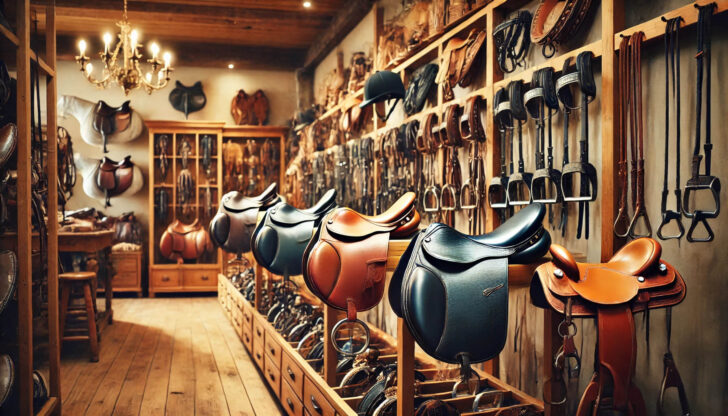
Equestrian tack is not merely equipment; it serves as the foundation for a safe and enjoyable riding experience.
Whether one is a beginner or a seasoned rider, understanding the fundamentals of tack is essential.
This article discusses the essential equipment that every rider should possess, including saddles, bridles, riding boots, and grooming supplies.
Additionally, it examines specialized tack for various riding styles and offers guidance on selecting the appropriate fit for both the rider and the horse.
Engaging with this information will provide valuable knowledge for your equestrian journey.
Table of Contents
Key Takeaways:
- A saddle and bridle are essential for all riders, regardless of riding style.
- Proper riding boots and a helmet are crucial for safety and support while riding.
- Grooming supplies are necessary for maintaining the health and appearance of your horse.
What is Equestrian Tack?
Equestrian tack encompasses the equipment and accessories utilized in horse riding, serving as essential components for both the rider and the horse to ensure safety, control, and comfort.
This gear is fundamental across various riding disciplines, including dressage, show jumping, and recreational riding, making it critical for individuals ranging from novice equestrians to experienced riders.
A comprehensive understanding of the various types of equestrian tack, such as saddles, bridles, and bits, is critical for selecting high-quality equipment that aligns with one’s riding style and enhances the overall riding experience.
Moreover, proper horse care extends beyond grooming; it necessitates the selection of appropriate tack to foster a strong partnership between horse and rider.
Basic Essential Tack for Every Rider
For every horse rider, regardless of whether they are a beginner or an experienced equestrian, possessing the appropriate basic essential tack is critical for both performance and safety.
Essential items include:
- A riding helmet, which is an critical safety feature,
- A high-quality saddle that fits both the horse and rider comfortably,
- A bridle with a bit to facilitate control.
Furthermore, riding boots and a safety vest are important for providing necessary protection and support during lessons and practice sessions.
The careful selection of this fundamental horse riding gear not only influences riding style but also enhances the overall experience, ensuring that both horse and rider feel secure.
Saddle and Bridle
Selecting the appropriate saddle and bridle is essential for every rider, as these components of tack significantly impact the comfort and performance of both the horse and the rider. A high-quality saddle ensures an optimal fit, which is crucial for the horse’s movement, while the bridle and bit facilitate necessary control and communication between the horse and rider.
A thorough understanding of the various types of saddles available, including English and Western styles, will enable novice equestrians to select the appropriate tack for their riding requirements, thereby ensuring a comfortable fit and an effective riding experience.
Each type of saddle serves a specific purpose; for example, dressage saddles prioritize close contact with the horse, which aids in achieving precision in movements, while jumping saddles are designed to promote a more forward position for improved balance during jumps.
Bridles also exhibit considerable variation—some are specifically crafted for more direct rein communication, whereas others emphasize comfort and sensitivity for the horse.
Ultimately, recognizing the significance of quality craftsmanship in both saddles and bridles can guide riders toward options that substantially enhance their riding experience, combining durability with design to ensure safety and performance in every ride.
Riding Boots and Helmet
Riding boots and helmets are essential components of equestrian apparel that ensure both safety and comfort for riders at all levels. A riding helmet is specifically designed to protect the head during unexpected falls, while riding boots provide necessary ankle support and a secure grip in the stirrups, thereby enhancing overall riding control.
The selection of a riding helmet that complies with established safety standards, along with a pair of riding boots that offers a comfortable fit, can significantly improve the riding experience. As such, these items are critical for both novice equestrians and experienced riders alike.
Proper riding boots not only support and protect a rider’s ankles but also facilitate ease of movement. Features such as waterproofing and breathable materials contribute to comfort during extended periods of use.
- Reputable brands, such as USG, provide reliable options that successfully combine functionality with style for various riding disciplines.
Furthermore, riding helmets are subject to stringent certifications that ensure they have undergone rigorous testing for impact resistance and ventilation. Selecting a helmet from recognized manufacturers that adhere to these safety regulations is of utmost importance, as it offers peace of mind while riding, knowing that one is adequately protected against potential injuries.
Grooming Supplies
Horse grooming is a critical aspect of equine care that extends beyond aesthetics; it is essential for maintaining the health and well-being of the horse. A comprehensive grooming kit typically includes fundamental items such as curry combs, brushes, hoof picks, and mane combs. These tools aid in the removal of dirt, debris, and loose hair, while also promoting proper circulation.
By incorporating regular grooming sessions into one’s routine, equestrians can strengthen their bond with the horse, while also enabling thorough checks for injuries or abnormalities, thereby ensuring optimal care and comfort.
Each tool within the grooming kit serves a distinct purpose:
- Curry combs are effective for loosening dirt and hair from the coat.
- Soft brushes are suitable for removing finer particles and dust, enhancing the horse’s shine.
- Hoof picks are essential for maintaining hoof health by preventing infections and ensuring the timely removal of stones or debris.
- Mane combs assist in detangling and maintaining a neat mane.
Consistent use of these grooming supplies not only promotes a clean and healthy coat but also facilitates the early detection of issues such as skin conditions or parasites. Therefore, implementing good grooming practices is fundamental to a horse’s overall vitality, making it imperative for every rider to prioritize this routine.
Additional Tack for Specific Riding Styles
Different riding styles necessitate specific tack to ensure optimal performance and safety, whether one is focusing on Western riding, English disciplines, or other equestrian sports.
Each style incorporates unique equipment tailored to its techniques; for example, Western tack is distinguished by its heavier saddles and specific bridles, while English riding emphasizes lighter gear and specialized saddles.
Understanding these distinctions is essential for novice equestrians as they explore their riding preferences and the appropriate horse riding gear that aligns with their chosen discipline.
English vs Western Tack
English and Western tack represent two distinct riding styles, each characterized by unique elements that influence not only the manner in which horses are ridden but also the equipment utilized, including saddles, bridles, and bits. English tack is generally lighter and more streamlined, tailored for disciplines such as dressage and show jumping, whereas Western tack is more robust, designed for rodeo events and trail riding.
A comprehensive understanding of these differences is essential for any equestrian seeking to select appropriate tack that enhances their riding experience and aligns with their preferred style.
The design choices inherent in each type of tack reflect the specific needs of both the rider and the horse, providing functionality that enhances performance and comfort. For example, the minimalist English saddle facilitates greater movement and closer contact with the horse, while Western saddles feature a deeper seat and larger fenders, offering increased stability for extended hours on the trail.
Each style of tack is meticulously crafted to optimize the rider’s control and the horse’s agility, accommodating various riding environments, whether in an arena or traversing rugged terrain. Equestrians should carefully consider these distinctions to ensure that their equipment complements both their riding style and the specific requirements of their horse.
Jumping vs Dressage Tack
Jumping and dressage tack serve distinct purposes within the equestrian field, each specifically crafted to enhance the rider’s performance in their respective disciplines. Jumping tack typically incorporates a forward-cut saddle, which provides greater freedom of movement—an essential element for overcoming obstacles. In contrast, dressage tack is designed with an emphasis on precision and communication, often featuring a deeper seat saddle that allows for improved control and balance.
Understanding the distinctions between these specialized equipment options is vital for equestrians seeking to excel in their chosen discipline.
Along with saddle design, bridles also exhibit significant differences between the two styles. Jumping bridles frequently utilize a stronger bit to ensure responsiveness during high-speed maneuvers, while dressage bridles, which may include a double bridle, are specifically engineered to facilitate subtle cues and enhance the horse’s natural responsiveness.
Moreover, the type of stirrups employed varies considerably; jumping riders typically prefer lightweight, flexible stirrups that allow for quick adjustments, whereas dressage riders choose sturdier options that promote stability.
Ultimately, the specific features of each type of tack are tailored not only to meet the physical demands of the horse but also to enhance the rider’s ability to communicate effectively. Therefore, selecting the appropriate equipment is essential for achieving success in equestrian pursuits.
How to Choose the Right Tack for You and Your Horse
Selecting the appropriate tack for both the rider and the horse necessitates a careful evaluation of several factors, including fit, comfort, and the specific requirements of both parties. This process is fundamental to achieving success in horse riding.
A properly fitting saddle is essential for the horse’s performance and well-being, while the rider must also ensure comfort with their equipment to perform optimally during riding lessons or competitions.
By ensuring that both the horse and rider are well-matched to their tack, the overall partnership and riding experience are significantly enhanced, making the selection of tack a crucial component of any equestrian’s journey.
Considerations for Fit and Comfort
The fit and comfort of tack are of paramount importance for the well-being of both the horse and rider, as they directly influence performance and safety during riding sessions.
A poorly fitting saddle can result in discomfort and pain for the horse, potentially leading to behavioral issues and performance problems.
Similarly, riding gear that lacks comfort can distract the rider, thereby affecting their focus and control. Consequently, understanding the significance of proper fit and investing in high-quality tack are essential for nurturing a harmonious relationship between horse and rider, ultimately ensuring safety during every ride.
To assess saddles, riders should carefully evaluate:
- Channel width
- Tree shape
- Overall construction
to ensure compatibility with the horse’s conformation. Bridles must also be examined for appropriate fit at the crown, cheekpieces, and noseband, as these elements significantly influence both comfort and communication. Furthermore, other equipment, such as girths and pads, should be selected with a focus on materials that minimize friction and pressure points.
Properly fitting tack not only enhances equine performance but also instills confidence in the rider, fostering a positive riding experience that prioritizes safety and enjoyment for both parties.
Learn more, How to Inspect and Maintain Your Horse Tack for Rider …
Budget and Quality
When purchasing horse riding gear, it is essential for any equestrian to balance budget and quality. Investing in high-quality tack ensures longevity and safety while reducing the need for replacements.
Although it may be tempting to choose less expensive options, particularly for beginner equestrians, the long-term advantages of quality items—such as saddles, bridles, and riding helmets—often outweigh the initial costs. Consequently, understanding which essential items merit investment can significantly enhance the riding experience and ensure the well-being of both horse and rider.
To achieve this balance, it is crucial to evaluate each piece of gear individually, emphasizing functionality and fit rather than solely focusing on price. Consider exploring various brands recognized for their durability and performance, as many reputable companies offer a range of products that accommodate different budgets.
Consulting online reviews and engaging with fellow riders can provide valuable insights into the best options available. Additionally, seeking out sales or second-hand items that still meet quality standards can facilitate informed purchasing decisions without compromising safety or comfort.









